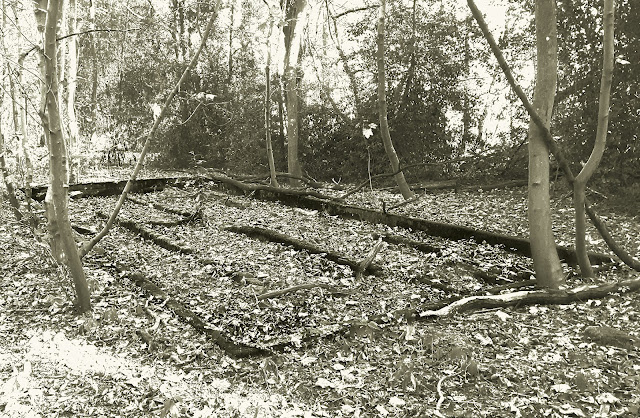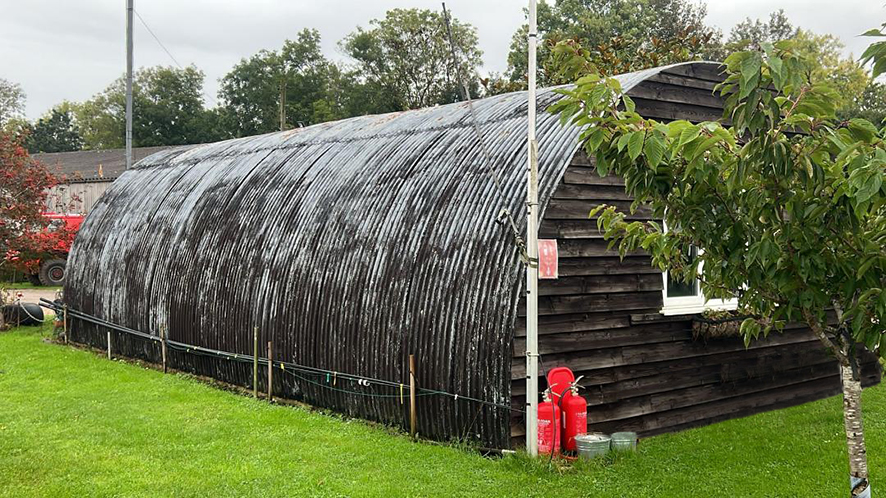Echoes of the Past
Whilst volunteering recently, Phil Riches got speaking to local Senacre resident Steve, who has been visiting Bicknor Wood for many years on dog walks. With a keen interest in history, Steve mentioned that a mass of new US Air Force aerial reconnaissance photos had recently been released on the Historic England website, dating from 1943-1944 and he wondered if any of them covered our local area. Following this tip-off, Phil did some investigational work, but sadly the newly released photos covered Bearsted and much of urban Maidstone but not Otham.
However, this RAF image from 1946 was available and shows Bicknor Wood and the surrounding area in great detail, captions have been added to help. From the map, you can see how the local landscape was very rural, with Park Wood still a woodland and none of the housing developments or industrial estates yet built. Thank you to Heritage England for their permission to use the photograph above.
We can see that Bicknor Wood has the same shape back then but there were a number of additional roads and trackways around it that were related to farming activities. Shadows indicate a few large trees which are no longer with us.
This closeup of the Gore Court Road end of the woods shows an area that has been felled, most likely for coppicing. We know that Bicknor Wood has been coppiced for centuries.
The aerial photo was taken just after the end of World War 2. Although Bicknor Wood itself has no known unusual features from that era, Otham's East Wood, just a short distance to the north, has a very rich wartime history and remnants of concrete foundations can still be seen to this day. In fact both of these woodlands were once part of the Gore Court Estate. Gore Court itself was used for military nursing use during World War 2. Information found online tells us that there was an area of Nissen huts in East Wood and these are considered to be the huts in which some of the soldiers from the 7th Battalion Royal Welsh Fusiliers undertook training. Another account recorded by the Imperial War Museum tells us that the 53rd Reconnaissance (Recce) Regiment were also seemingly posted to Otham during their 1943-1944 training with someone from that regiment describing Otham as a ‘wild place’ with ‘accommodation in Nissen huts’.
Digging deeper online, it is also mentioned that in October 1943, the Regiment moved from its camp in East Wood to an old manor house some 20 miles away in the village of Smeeth, on the outskirts of Ashford.
An example of a restored Nissen hut. Credit: Stephen MacHaye, Norfolk Tank Museum
A Nissen hut is a prefabricated steel structure, originally for military use, made from a half-cylindrical skin of corrugated iron, a wooden frame and a concrete base. They were designed during the First World War by the Canadian-American-British engineer and inventor Major Peter Norman Nissen and were also used extensively during the Second World War. There had been a little variation in the design, but all feature the same distinctive shape.
Below are a number of photos taken in East Wood recently which show the foundations of these Nissen huts and other wartime buildings. The forest has reclaimed them now and after some 80 years or so, all that really remains is covered in moss.
With the horror of recent wars starting around the world, it does make you think just what was going through the troops' minds whilst they were training here in Otham.
Useful link: https://historicengland.org.uk/images-books/archive/collections/aerial-photos/record/RAF_106G_UK_1093_RP_3103


















Comments
Post a Comment